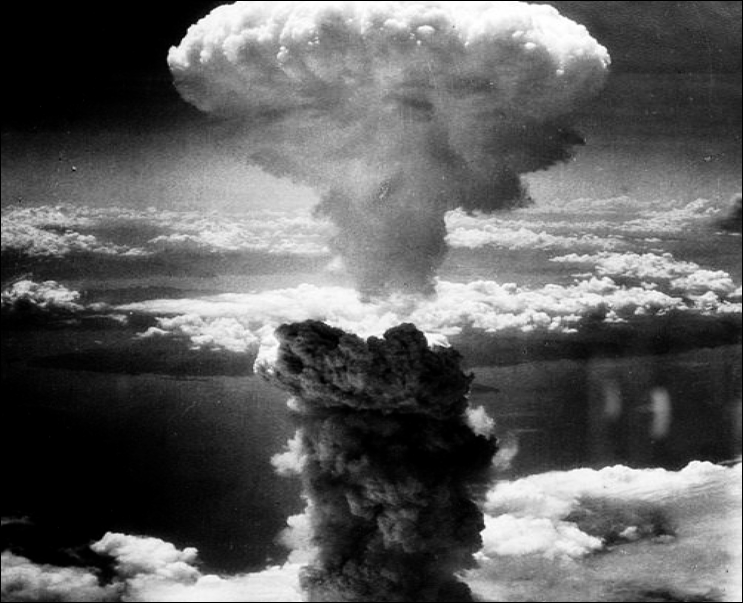Winner of the Spring 2017 StMU History Media Awards for
Best Article in the Category of “World History”
“We knew the world would not be the same. A few people laughed, a few people cried, most people were silent. I remembered the line from the Hindu scripture the Bhagavad Gita. Vishnu is trying to persuade the prince that he should do his duty and to impress him takes on his multiarmed form and says, ‘Now, I am become Death, the destroyer of worlds.’ I suppose we all thought that one way or another.”1
- J. Robert Oppenheimer, The Decision to Drop the Bomb

Throughout the history of human warfare, conflict has pushed humans to innovate–to build ever larger and deadlier weapons, each more lethal than the last. However, it was not until World War II and the invention of the atomic bomb that humanity has been able to kill on such a massive and efficient scale. Case in point, in the final days of World War II, the United States carried out one of the most chilling instances of mass murder in the history of humanity: the bombing of the Japanese cities of Hiroshima and Nagasaki. These attacks ultimately killed an estimated 294,000 people, the majority of whom were noncombatants.2 In comparison, the Japanese attack on Pearl Harbor killed just 2,408 American citizens, although this is largely due to the focused Japanese attack on military targets, namely the Pacific fleet and U.S. airfields.3 To give a more modern frame of comparison, the terrorist attacks against the World Trade Center and Pentagon, considered to be by far the worst terrorist attacks against the United States, claimed the lives of 2,974 American citizens.4
In the spring of 1945, World War II was entering its final stages. The Allies had already achieved victory in Europe with Germany’s surrender on May 7th, but the conflict on the Pacific front was still going strong. In the years leading up to the two World Wars, Japan’s victories against two larger countries–China in the Sino-Japanese War (1894–1895) and Russia in the Russo-Japanese War (1904–1905)–combined with other factors, forged a strong sense of Japanese nationalism, militarism, and cultural superiority. This fervent nationalism, integrated with the Japanese warrior ethic known as bushido, made the prospect of a Japanese surrender unlikely, even as the Allies began to position for an invasion of the Japanese mainland.5

Concurrently, since as early as 1942, President Franklin Delano Roosevelt had been secretly sponsoring and funding The Manhattan Project, the code name used for the $2 billion U.S. effort to develop a nuclear weapon before the Germans. A team of top physicists led by Dr. Julius Robert Oppenheimer were assigned to this project, a task so secret that not even individuals as important as then Vice President Harry S. Truman was aware of it. Shortly after Roosevelt’s untimely death and Truman’s subsequent inauguration to the presidency in April 1945, he was informed that the Manhattan Project was approaching success–that a nuclear weapon would be feasible in just four short months.6
Faced with the prospect of a costly and deadly invasion of Japan, Truman and his advisors were faced with a difficult choice: utilize this new atomic weapon or try to defeat Japan through conventional means. In late July, the United States issued the Postdam Declaration, a statement which gave Japan the choice between unconditional surrender or total annihilation. When this declaration went ignored, President Truman authorized the use of the atomic bomb.7

On the morning of August 6, 1945, Colonel Paul Tibbets piloted the Enola Gay over the city of Hiroshima, where his crew dropped an atomic bomb code-named “Little Boy.” Upwards of 70,000 people died instantly in the blast. Additionally, 48,000 buildings were destroyed and another 22,000 were damaged, leaving only 6,000 buildings untouched. Three days later, on August 9th, a second bomb was dropped onto Nagasaki, killing another 36,000 people. In total, an estimated 295,000 were killed in the blasts or from complications from the resulting nuclear fallout.8
Emperor Hirohito ordered the surrender of Japan on August 10, 1945. On August 15th, radios across Japan broadcasted Hirohito’s words as he read the declaration of surrender to the Japanese people, thus ending World War II. The bombs’ effectiveness in forcing the Japanese to surrender is still subject of popular debate among historians to this day, given that the Russian invasion of Japan-controlled Manchuria occurred at the same time of Nagasaki, both of which likely impacted Japan’s will to continue fighting.9 Even so, while the political and military effects of these blasts may be debated, none can contest their tragedy and devastation.

- Jason Pontin, “Oppenheimer’s Ghost,” MIT Technology Review, October 15, 2007. https://www.technologyreview.com/s/408835/oppenheimers-ghost/. ↵
- Dennis W. Cheek, “Hiroshima and Nagasaki,” in Encyclopedia of Science, Technology, and Ethics, edited by Carl Mitcham, Vol. 2, Detroit: Macmillan Reference USA, 2005. Gale Virtual Reference Library (accessed February 6, 2017), 923. ↵
- Sonia Benson, Daniel E. Brannen, Jr., and Rebecca Valentine, “Pearl Harbor Attack,” in UXL Encyclopedia of U.S. History, Vol. 6, Detroit: UXL, 2009. Gale Virtual Reference Library (accessed February 6, 2017), 1208. ↵
- Stefan M. Brooks, “September 11 Attacks,” in The Encyclopedia of Middle East Wars: The United States in the Persian Gulf, Afghanistan, and Iraq Conflicts, edited by Spencer C. Tucker, Vol. 3, Santa Barbara, CA: ABC-CLIO, 2010. Gale Virtual Reference Library (accessed February 6, 2017), 1096. ↵
- “The United States Drops the Atomic Bomb on Hiroshima and Nagasaki,” in Global Events: Milestone Events Throughout History, edited by Jennifer Stock, Vol. 2, Asia and Oceania, Farmington Hills, MI: Gale, 2014. Gale Virtual Reference Library (accessed February 5, 2017), 361. ↵
- “An Overview of the Atomic Bombings of Hiroshima and Nagasaki,” in The Atomic Bombings of Hiroshima and Nagasaki, edited by Sylvia Engdahl, Perspectives on Modern World History, Detroit: Greenhaven Press, 2011. Gale Virtual Reference Library (accessed February 6, 2017), 13-14. ↵
- “An Overview of the Atomic Bombings of Hiroshima and Nagasaki,” in The Atomic Bombings of Hiroshima and Nagasaki, edited by Sylvia Engdahl, Perspectives on Modern World History, Detroit: Greenhaven Press, 2011. Gale Virtual Reference Library (accessed February 6, 2017), 14-15. ↵
- Dennis W. Cheek, “Hiroshima and Nagasaki,” in Encyclopedia of Science, Technology, and Ethics, edited by Carl Mitcham, Vol. 2, Detroit: Macmillan Reference USA, 2005. Gale Virtual Reference Library (accessed February 6, 2017), 923. ↵
- “The United States Drops the Atomic Bomb on Hiroshima and Nagasaki,” in Global Events: Milestone Events Throughout History, edited by Jennifer Stock, Vol. 2, Asia and Oceania, Farmington Hills, MI: Gale, 2014. Gale Virtual Reference Library (accessed February 5, 2017), 361. ↵



152 comments
Bailey Rider
Thank you for another fantastic article Cameron, I always really enjoy reading your articles and I strive to write like you. It is interesting to look at what led up to the bombings and to look at the Manhattan Project, which was so secret that the vice president did not even know about it! That’s crazy. It’s also hard to believe that we made the choice to kill so many people, even non soldiers. Thanks for the thought invoking article.
Alyssa Vela
I read this article toward the beginning of the semester, and somehow it got better the second time around! Re-reading was as though I was getting another refresher, all the while learning something new. Once again, your sentence structure was really interesting. There was a lot of detail put into this, which meant you did a lot of research. That, is partly why I believe you got nominated for “Best overall research” This was such an amazing article!
Teresa Valdez
This article is very thought provoking. The detail in this article is very rich. It is clear that a lot of research was put into this article. The comparisons between the lives lost in the bombings of Nagasaki and Hiroshima compared to the lives lost during the terrorist attacks of 9/11 and Pearl Harbor were a relatable reference point that really helped put the magnitude of the decision into perspective. I am really curious how many live were at stake if the US had continued the war using conventional means.
Nelson Smithwick
Starting this article with the quote by Robert Oppenheimer is one of my favorite introductions on this blog. It effectively communicates the sheer destructive power that had just been created. This helped solidify the idea that the atomic bomb was such a dangerous and world changing invention. After the creation of nuclear arms, war and in fact the entire world, would never be the same again.
Lianna Ybarra
I think that this event is so tragic. It is so sad that many innocent lives were lost but if the US hadn’t dropped the bombs the fighting would have kept on and many more lives would have been lost. All I know is that I would not want to have been on the decision side of that bomb because either decision still ends in tragedy. I really liked how you developed the article and opened up with the quote from inside of the decision making. It really adds a lot to you’re article!
Erick Martinez
This was a very informative article that was very well written. Considering how World War 2 was already coming to a close makes me wonder if the bombings were truly necessary. I just can not see the Japanese making an attempt to defeat the Allied Powers on their own, especially after watching Germany fall. Thank you for taking time to write such a great article and ensuring that the bombings of Hiroshima and Nagasaki are never forgotten
Isabelle Salinas
This article is very well written and informative. I like how you briefly added the debates on whether the US should have dropped it or not. It leaves us readers something to look up on our own. I’ve always had an interest in the Manhattan project and its story continues to interest me in this article. Great job!
Tyler Sleeter
Very informative article. I often hear about the success of the US over Japan is due to the bombing of these cities, but rarely do I hear anything about the devastation of the bombings. I did not know that so many people had been killed and that so few buildings were left standing. It is hard for me to accept that so many of the killed were civilians, the women and children that are always supposed to be protected, but the US failed to do so this time. This could not have been an easy decision for the political powers to make but I am glad that we have not repeated that mistake again.
Ana Gonzalez
Great job Cameron! I enjoyed reading your article as it flowed nicely and was well organized. You did a great job emphasizing how catastrophic the results were on Japanese civilians. Although I understand that these nuclear weapons did end the war, I believe that nuclear warfare should be avoided since it causes more harm than good. It is important that nations look back at the bombings of Nagasaki and Hiroshima during conflicts since it is a remainder that nuclear weapons are deadly solutions.
Faisal Alqarni
Hi Cameron, The nondiscriminatory nature of weapons of mass destruction in the lives they take is what makes me be a firm believer that they should be done away with. Hiroshima and Nagasaki I believe should serve as a warning as to the effects such weapons they can have. I appreciate you writing about such as an issue because it reminds us of the devastating losses that such weapons have. Good paper thank you.